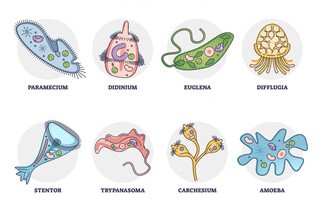Invertebrate
Zoology "protozoa"
Protozoa are unicellular, heterotrophic, eukaryotic organisms that are found worldwide in most habitats. Most protozoans are free living, but some species cause major human parasitic diseases such as malaria, African sleeping sickness, and amoebic dysentery.
For many years the four main groups of protozoa were flagellates, amoebae, ciliates, and apicomplexans. Because the true evolutionary relationships of many protozoan groups have yet to be elucidated, the taxonomic scheme that we will use continues to follow the principles of traditional taxonomy rather than cladistic taxonomy. Consequently, some of the taxa we will discuss may be either polyphyletic (members of the taxon do not share a common ancestor) or paraphyletic (the taxon does not include all descendants of the common ancestor). The reason for this approach is that it is a compromise between reasonably current evolutionary thinking and the practical need for a system of nomenclatures that allow us to communicate with each other and retrieve information from the older literature. Keep in mind that modifications to the present scheme of protozoan classification are continually being proposed as the results of new ultrastructural and molecular studies are published.
 |
protozoa
2.
Characteristics: unicellular, motile
(usually) eukaryotes
3.
All symmetries are represented in the group, with variable
or constant shape (oval, spherical and others).
4.
Many protozoans are symbiotic,
taking the lifestyles of: mutualists (both species benefit), commensuals
(one species benefits, the other is unaffected) or parasites (one species benefits, the other is harmed).
5.
All types of nutrition are represented in the protozoans: autotrophic, heterotrophic, saprozoic.
6.
Protozoans utilize pseudopodia, flagella or cilia for
locomotion; some are sessile.
7.
Reproduction
may be by binary fission, budding or multiple fission (asexual forms
of reproduction) or sexually by the formation of gametes.
8.
Some protozoans produce a
cyst stage designed to endure unfavorable environmental conditions.
9.
Certain protozoans have had, and continue to have,
profoundly important influences on human health and welfare. |